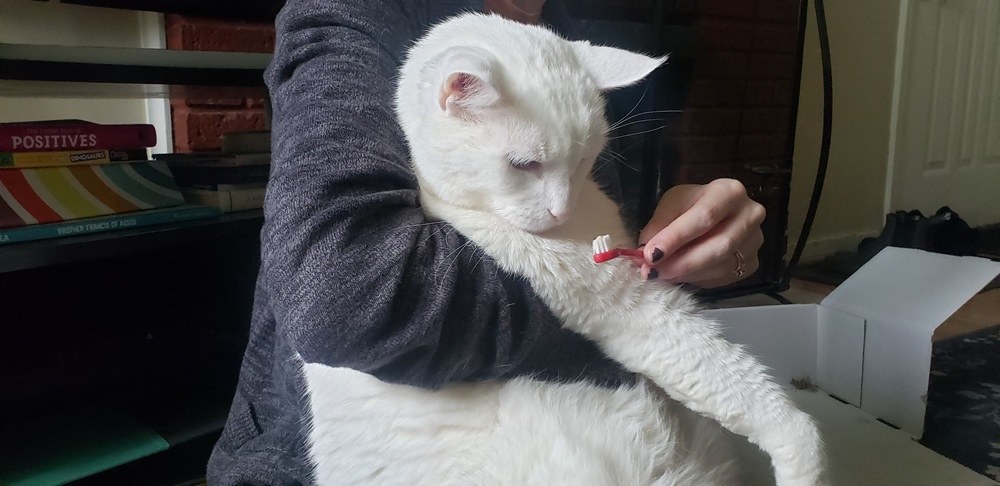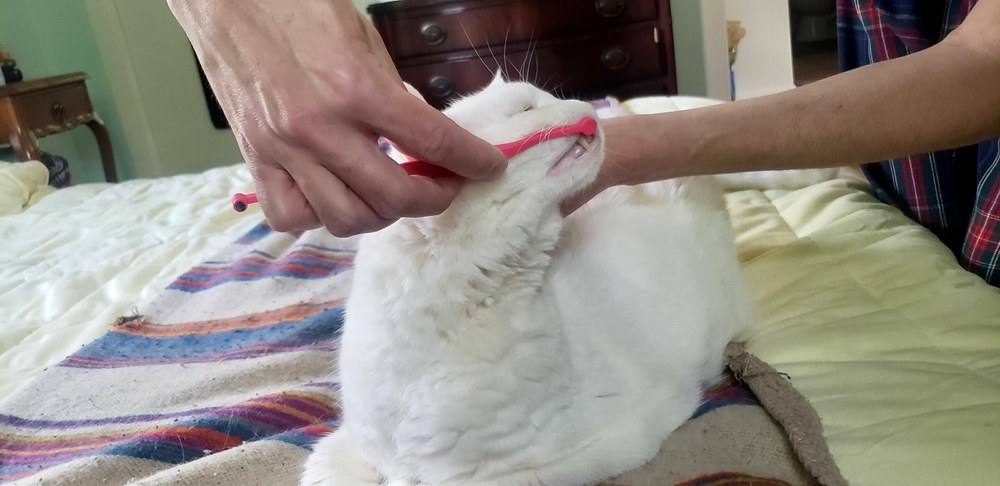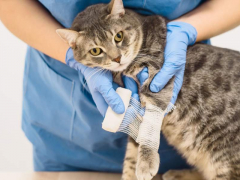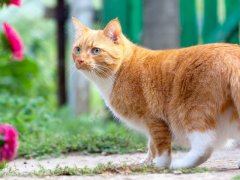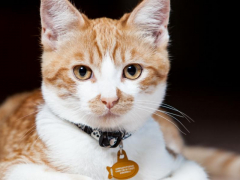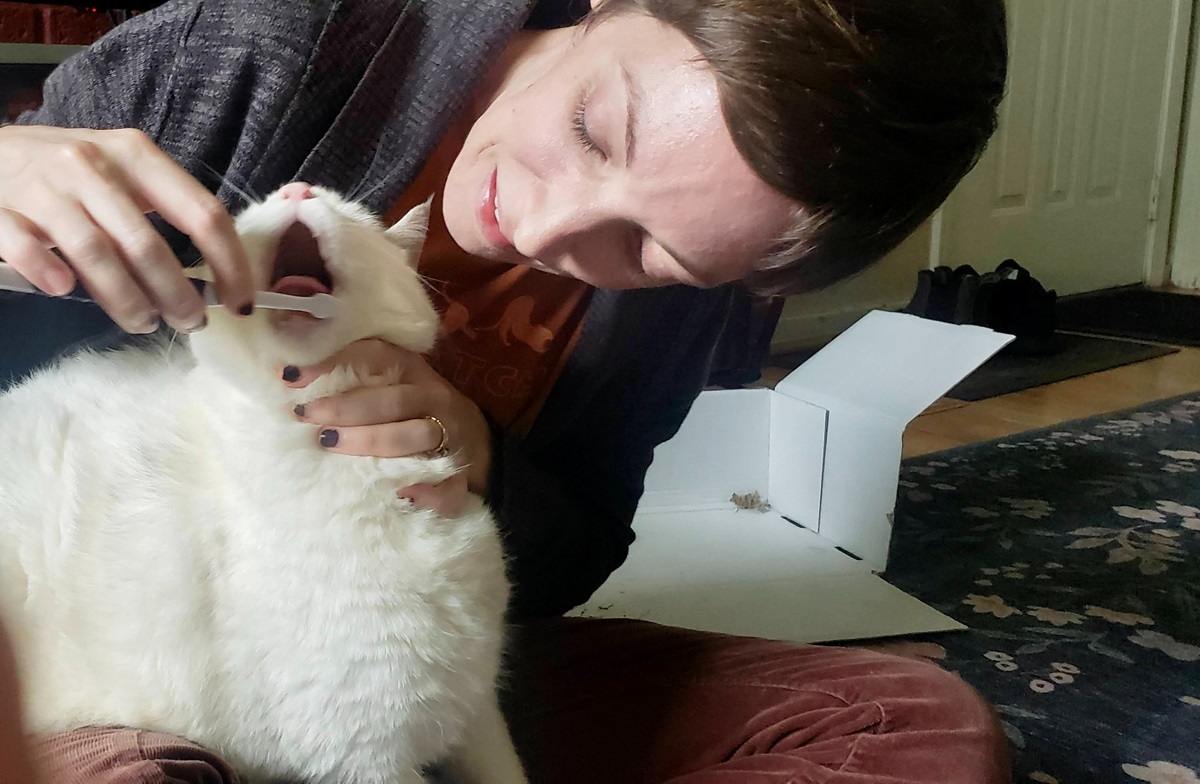
Liz Coleman / Cats.com
Do you brush your teeth? How about your cat’s? Toothbrushing in pets is a powerful way to protect your cat’s dental health.
Cats can be fussy and the thought of trying to persuade your cat to stand still long enough for you to brush their teeth every day can be a little off-putting to even the most dedicated toothbrushing enthusiast. The good news is, with a little patience, positive reinforcement, and practice, your cat can learn to love having their teeth brushed.
This is an important process to teach your cat because, cats, just like people are susceptible to dental disease and decay. Toothbrushing has been shown to be one of the best preventative health measures for delaying the onset of dental disease. Although toothbrushing alone will not completely prevent dental disease, it reduces the rate of plaque and tartar buildup and increases the longevity of your cat’s teeth.
The Importance of Brushing Your Cat’s Teeth
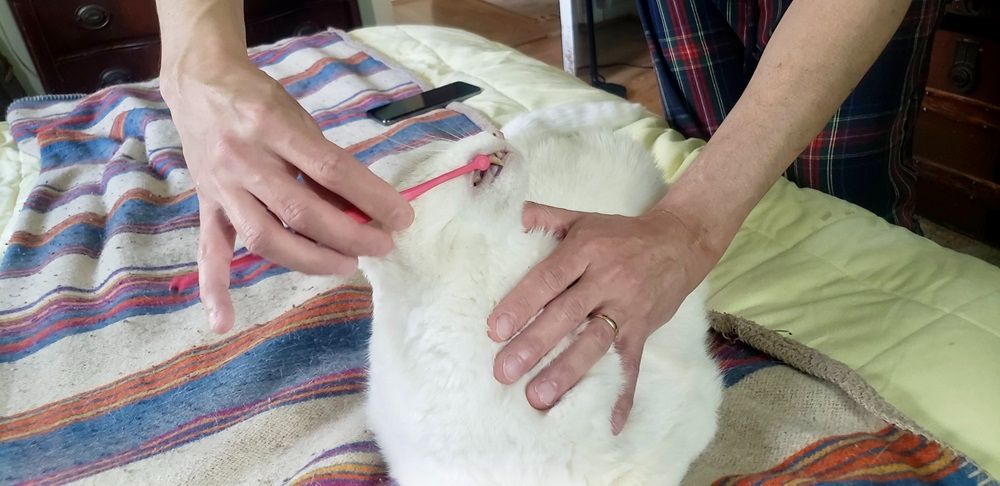
Liz Coleman / Cats.com
Dental disease is a painful condition for cats. When we do not clean or brush our cat’s teeth, it allows plaque buildup on the teeth and bacteria sticks to the surface of the teeth. The bacteria cause inflammation of the gums (gingivitis), and in time lead to decay of the teeth. The teeth then become diseased and fall out. The bacteria can travel in the bloodstream to the heart, liver, and kidneys causing diseases such as endocarditis. This can make your cat very unwell.
Signs of dental disease in cats include:
- Bleeding gums
- Hypersalivation or drooling
- Reduced appetite
- Eating on one side of the mouth
- Difficulty chewing
- Smelly breath
- Weight loss
If you see these signs, you should contact a veterinarian for help.
A Step-by-Step Guide to Brushing A Cat’s Teeth
Cats prefer a slow and steady approach to toothbrushing. If you’ve never brushed your cat’s teeth, go slowly until your cat accepts this necessary routine.
- Start by introducing the toothpaste first. Put a small amount of toothpaste, around the size of a pea onto your index finger. Let your cat smell, and lick the toothpaste from your finger. Toothpaste for cats usually comes in tasty flavors such as malt and poultry so are enticing flavors for your cat. Most cats will be interested and want to taste the toothpaste.
- Use lots of praise to encourage your cat to taste the toothpaste. You can also use rewards such as your cat’s favorite treat to teach your cat to like this activity. Do not force the toothpaste into your cat’s mouth or onto the lips as this can create a fear aversion to toothpaste and they will not want to let you progress to brushing the teeth.
- When training your cat to enjoy toothbrushing try not to hold your cat tightly or use wraps to make them stay still. Restraining your cat can create a fear of toothbrushing.
- When your cat is comfortable tasting or licking the toothpaste, start to introduce the toothpaste on a finger brush or piece of gauze around the lips and into the sides of the mouth. Again continue with lots of praise and the odd treat to remind your cat how happy you are they are allowing their mouth to be handled.
- If your cat is accepting of this, you can move on to brushing the teeth. Start with just a few teeth at a time and gradually work up to brushing the whole mouth. We recommend brushing your cat’s teeth once daily for the rest of their life.
- You can start brushing your cat’s teeth at any stage of life, but the earlier the better. Kittens have deciduous teeth (baby teeth) that will fall out, and these are the perfect teeth to practice toothbrushing on. Even if your cat is much older, and has never had their teeth brushed before, you can still teach your cat to enjoy having their teeth brushed.
Using the correct toothbrush and toothpaste will set you up for success. Using pet-specific products is not only safest, it also makes the process easier for both you and your cat. Here are our top tips when buying dental hygiene products.
1. Toothbrush
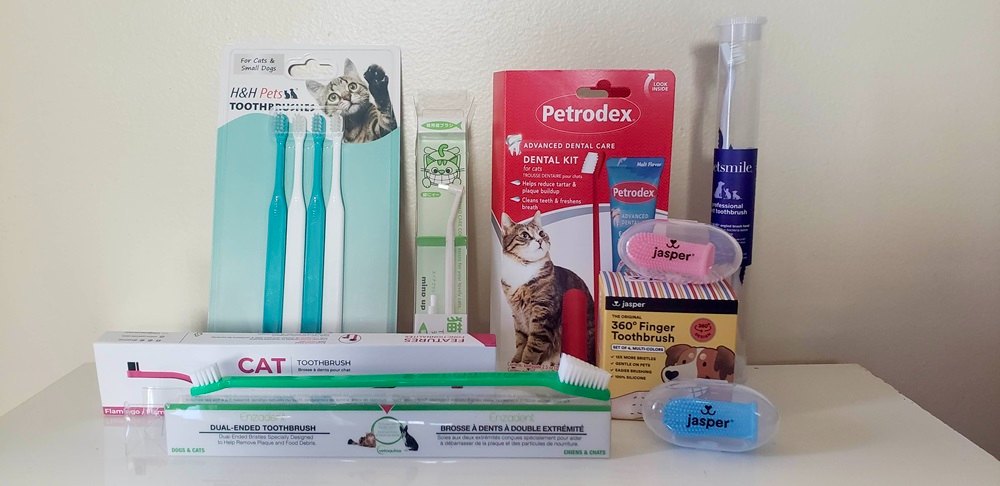
Liz Coleman / Cats.com
When choosing a toothbrush, you have a few options. A pet finger toothbrush fits over the end of your index finger and is nice and short to fit into the back of the mouth easily. If your cat bites, this might not be the toothbrush for you.
Pet toothbrushes have a small, soft diamond-shaped head with a long handle. They have been specifically designed to reach into your cat’s mouth easily, and the bristles are softer than human toothbrushes making the brushing experience more tolerable to cats.
Although you can use a human toothbrush, they are often too bulky to comfortably fit into a cat’s mouth and the bristles can be too stiff. A child’s toothbrush would be the next best choice if you cannot obtain a pet toothbrush.
Also Read: Best Toothbrushes For Cats
2. Toothpaste
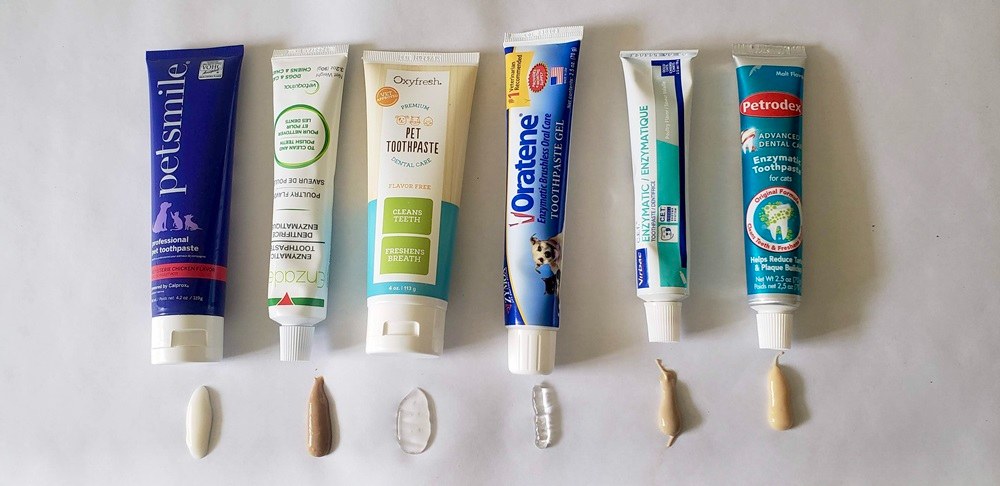
Never use human toothpaste on a cat as this can be toxic to your pet. Liz Coleman / Cats.com
When choosing a pet toothpaste, you must use a pet-specific product. Human toothpaste often contains xylitol and fluoride, which are both toxic to cats. Cat toothpaste has been created without these ingredients and therefore should be the only choice of toothpaste for your cat.
Cat toothpaste comes in different flavors such as poultry or malt, and pet shops or your veterinarian might have sample packets so you can try different flavors to see which one your cat prefers most before buying a whole tube.
Also Read: Best Dental Toothpaste For Cats
How Often to Brush Cat Teeth
To maintain your cat’s oral health, daily brushing is most beneficial. However, if that’s not realistic, aim for at least three times a week to remove plaque and prevent tartar accumulation. Starting when your cat is a kitten makes the process easier, but even with older cats, it’s worth the effort. Regular dental checkups and professional cleanings
Professional Cleaning
Some cats, even with lots of training and patience will not let you brush their teeth. If this is the case with your cat or kitten, you will need a professional to clean your cat’s teeth for you. Your veterinarian can safely remove the tartar buildup using an ultrasonic scaler under general anesthesia. This allows all surfaces of the teeth to be cleaned, including under the gum line.
The veterinarian examines the mouth for signs of tooth decay, infection, and masses at the same time as the dental cleaning procedure. Further tests such as dental x-rays can be taken to look at the roots of the teeth to make sure they are healthy.
Diseased teeth are removed in cats to prevent ongoing pain and infection, and your cat will feel much happier without diseased teeth in their mouth. Cat owners are often concerned that their cats will not be able to eat without their teeth, but cats actually cope rather well with eating after tooth removal.
All cats should get a yearly dental checkup with a veterinarian as signs of dental disease can be very subtle and go unnoticed.
Also Read: Basepaws Cat Dental Health Test Review: We Tried It
Additional Dental Products For Cats
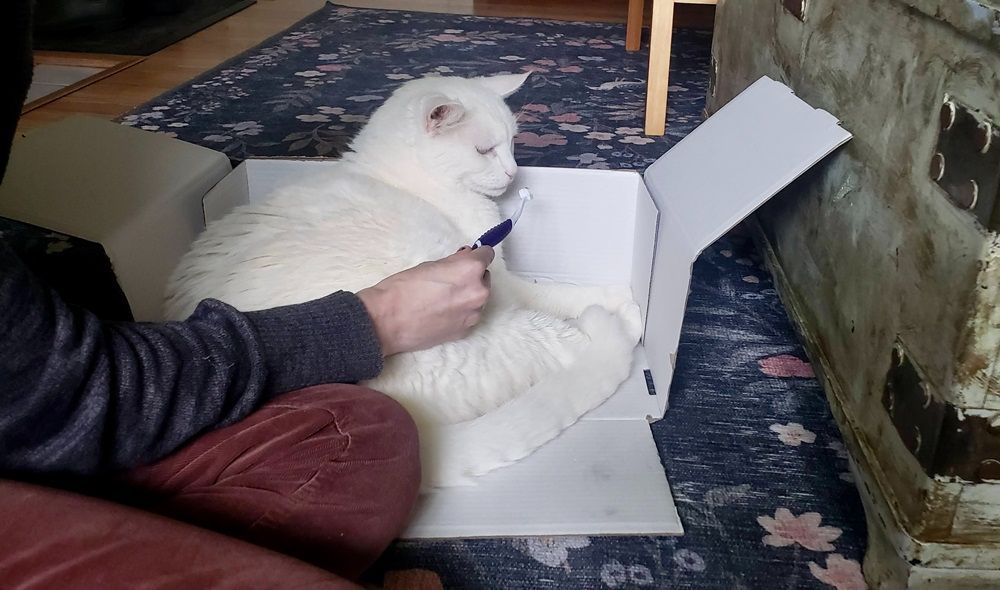
Other oral health products that complement toothbrushing include dental chews, rinses, and water additives. Liz Coleman / Cats.com
There are many dental products marketed to cat owners to maintain good oral hygiene in our cats. These products include dental toys, dental treats, prescription dental diets, and mouthwashes. These products can be used alone or in combination with each other to aid in good oral hygiene. The most important thing when considering a dental product is to look for products with scientific backing.
The Veterinary Oral Health Council has a recommended list of products shown to be effective in cats. We recommend using the products on this list. If you are considering buying a product, not on this list, ask a veterinarian first for their advice on how effective it is, or if an alternative might be more suitable for your cat’s needs. This can save time, and money but also the heartache of using an ineffective product without the desired effect of keeping your cat’s teeth healthy.
Also Read: The Complete Guide To Dental Cleaning For Cats
So to sum things up, many cats actually do enjoy the attention and tasty treat of having their teeth brushed, and once a routine is created will come looking for you if you forget it’s toothbrushing time! It’s never too late to start caring for your cat’s teeth, so give toothbrushing a try today.
-
http://www.vohc.org/accepted_products_cats.html
